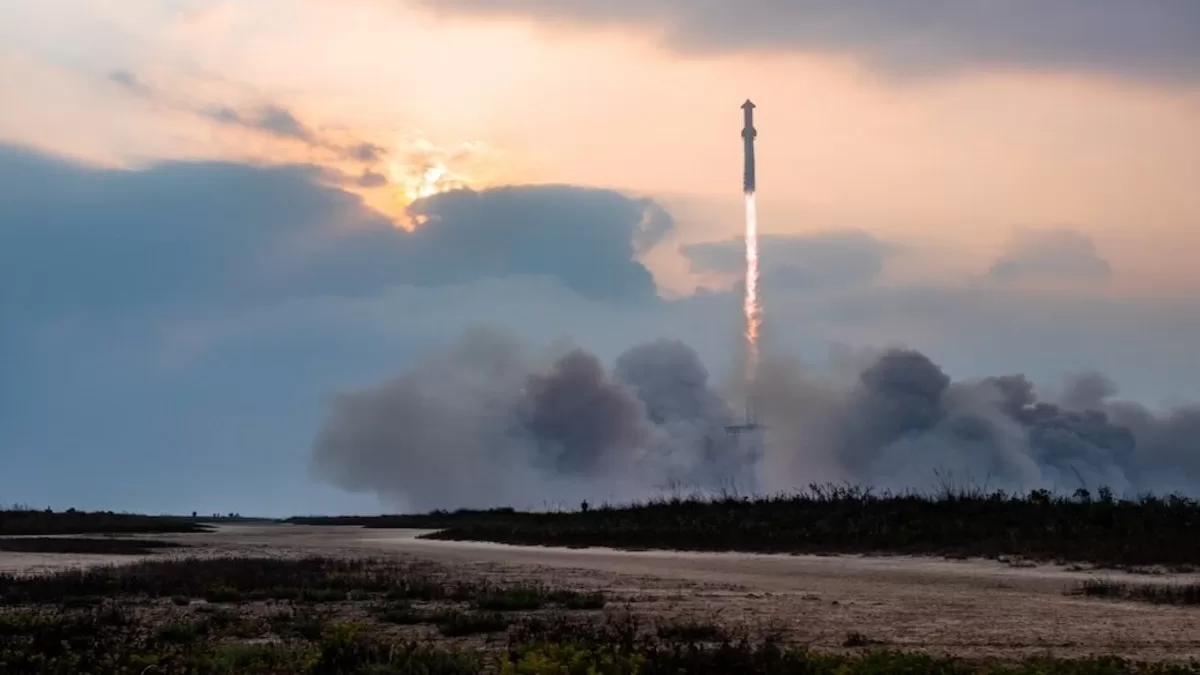For a fourth time in program history, SpaceX launches its Starship rocket from its Starbase facility in southern Texas. Image: Adam Bernstein/Spaceflight Now
For the fourth time in just over a year, SpaceX has launched its colossal Starship rocket from the Starbase facility in southern Texas. Dubbed Flight 4, this mission marks a significant milestone with the first successful soft splashdown of both the Super Heavy Booster and the Starship upper stage.
Liftoff occurred at 7:50 a.m. CDT (8:50 a.m. EDT, 1250 UTC), from a 120-minute launch window. Unlike previous flights, Flight 4 did not carry a payload and followed a suborbital trajectory. The successful splashdown sets the stage for SpaceX’s goal of creating a reusable rocket system.
Mission Details and Improvements
Flight 4 saw Ship 29 stacked atop Booster 11 to form the 121-meter (397-foot) Starship rocket. Elon Musk, SpaceX founder, highlighted the mission’s aim to reenter deeper into the atmosphere, achieving maximum heating. Post-mission, Musk celebrated Starship’s reentry success, despite the loss of many tiles and a damaged flap.
In Flight 3, the upper stage faced uncontrollable rolling, preventing engine relight. Despite this, the rocket streamed high-definition reentry footage via the Starlink satellite network. SpaceX attributed the roll to clogged roll control valves, which have since been improved with additional thrusters for better redundancy.
The Super Heavy Booster in the previous flight shut down six of its 13 Raptor engines prematurely, causing a failed landing attempt. SpaceX has now upgraded the boosters with better filtration hardware to prevent future issues.
Eyes on the Moon
Flight 4’s success is crucial for both SpaceX and NASA, particularly for the upcoming Artemis 3 mission, targeting a September 2026 launch. Lisa Watson-Morgan, manager of NASA’s Human Landing System (HLS) program, expressed optimism about SpaceX’s progress. The collaboration aims to ensure the rocket is ready for lunar missions, including the Artemis 3 and 4.
One notable success from Flight 4 was the propellant transfer test, fulfilling a $53.2 million contract with NASA’s Space Technology Mission Directorate. This test is a stepping stone towards the larger goal of ship-to-ship propellant transfer, essential for future Moon and Mars missions.
Future Prospects
Looking ahead, Musk teased ambitious plans for Flight 5, including catching the Super Heavy Booster with the launch tower’s “chopsticks.” This innovation aims to further enhance the reusability of the rocket system.
SpaceX is also expanding its launch infrastructure, building a second tower at Starbase. Components for the new tower, manufactured at NASA’s Kennedy Space Center, are being transported to Texas. The Federal Aviation Administration (FAA) is currently reviewing plans for up to 44 Starship launches annually from Kennedy Space Center’s Launch Complex 39A.
Human Element
NASA’s HLS program continues to involve astronauts in the development process, ensuring the spacecraft meets human-rated standards. Recent tests included NASA and Axiom Space astronauts conducting integrated tests of spacesuits and the Starship’s airlock.
Shorter Turnaround
The timeline between Starship launches is shortening, with the interval between flights reducing from 212 days (Flight 1 to 2) to just 84 days (Flight 3 to 4). SpaceX aims for a monthly launch cadence, incorporating lessons from each flight to enhance future missions.
The FAA has outlined conditions under which SpaceX’s test-induced damage would not require an investigation, potentially speeding up the approval process for future flights.
With the successful completion of Flight 4, SpaceX is poised to make significant strides in its quest for reusable rocket technology and interplanetary exploration.
#SpaceX #Starship #SpaceExploration #ReusableRockets #SpaceTechnology
